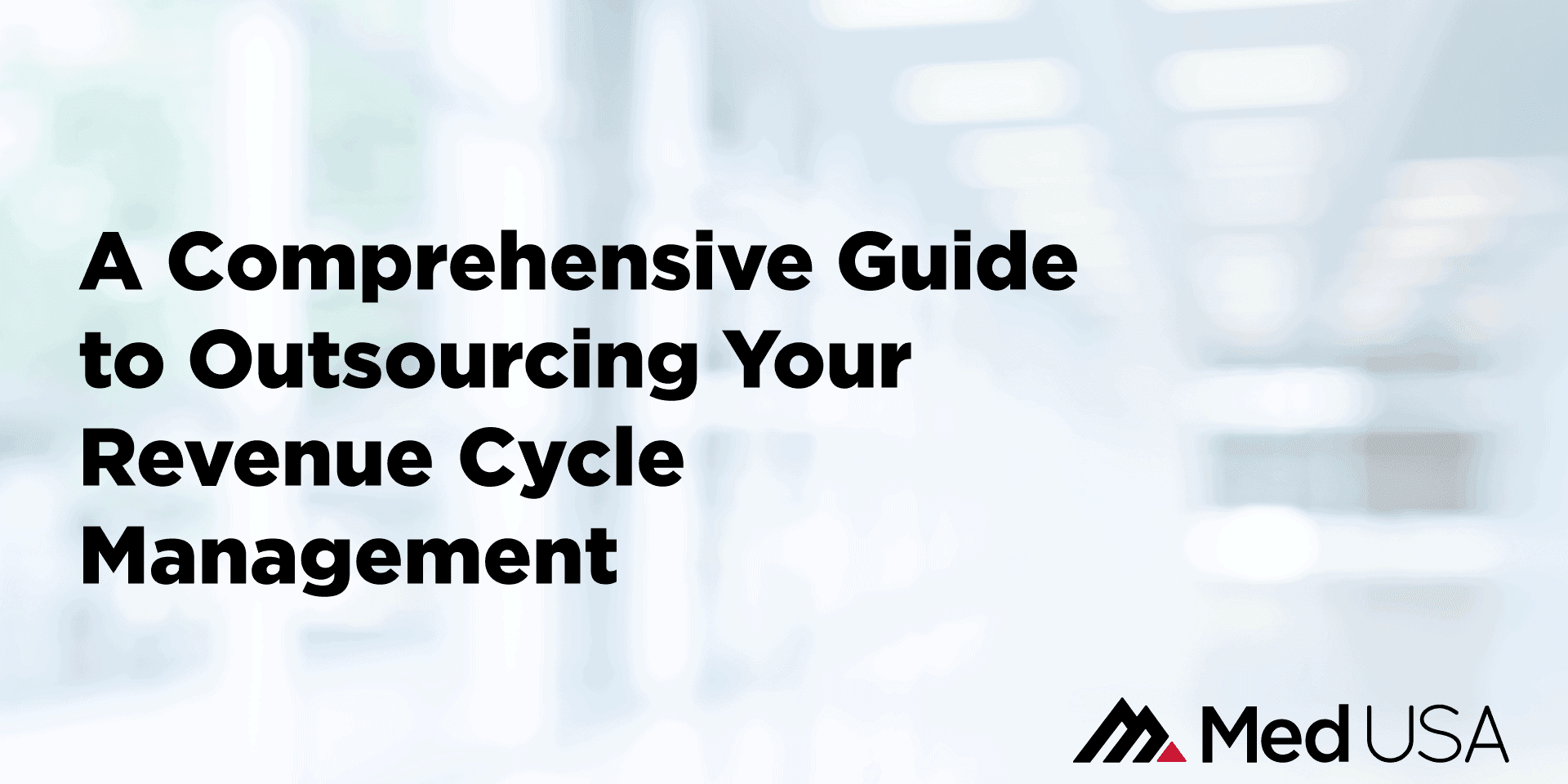
A Comprehensive Guide to Outsourcing Your Revenue Cycle Management
In a perfect world, the art of providing healthcare would involve nothing more than a series of one-on-one interactions between a physician and a patient. The patient would pay for the services rendered, the physician would use the payment to purchase goods to continue his practice, and the cycle would begin again. Of course, this scenario is little more than an overly simplified view of our current healthcare system that hasn’t existed for hundreds of years.
Today – whether by necessity or by design – providing medical care isn’t just about the doctor-patient relationship anymore. On the contrary, we’ve instituted government programs and insurance companies to allow providers to extend care to individuals who may not otherwise be able to afford it as well as to ensure physicians receive payment for their services. Meanwhile, technological innovations have allowed us to provide a greater standard of care and more intricate procedures than ever before; others have become a key repository for patient data, including health records, treatment information, and more.
These instances, along with many others, have transformed healthcare into the huge yet intricate system we experience today. While many of these measures were developed to provide security, necessary oversight, and accessibility for patients and providers alike, they’ve also combined to add a series of additional steps to the process of receiving care. The result is an increasingly complicated – and increasingly expensive – healthcare system in the United States.
With a total healthcare spend expected to reach $6.0 trillion by 2027 according to the CMS, it’s no surprise that the costs of receiving healthcare and the cost of providing healthcare have risen in conjunction. While medical costs to consumers have risen by 4.6%, a key question remains – how do healthcare operations manage the delicate balance between the fact that they’re handling more procedures, more providers, more regulations, and more money than ever before, all while keeping a handle on expenditures coming from inside the office? The answer is revenue cycle management.
What Is Revenue Cycle Management?
Revenue cycle management, or RCM, is a term used to define the process healthcare organizations use to track each patient care case through each and every step of the relationship. Beginning with the initial registration and appointment scheduling through the actual care and service provided, then through the billing cycle, revenue cycle management aims to centralize all financial data related to each patient into one place. As such, RCM merges both the clinical and business sides of a practice by providing a platform to manage treatment and healthcare data with administrative information like their name, billing information, insurance provider, and more.
FAQs About RCM: Answered
This brief FAQ addresses some common questions regarding the nature of RCM and how it is used in healthcare organizations:
Q: What does RCM accomplish?
A: For providers, a key function of RCM is facilitating communications with patient insurance companies and other payers. From scheduling to determining necessary care and billing, all measures of communication between the providing office, payer, and patient can be handled with RCM information. Without RCM, individual communications between all three parties are subject to error.
Q: What are the parts of the revenue cycle?
A: As mentioned, the revenue cycle incorporates all functions from both the administrative and clinical parts of a healthcare organization to allow the process to continue efficiently. The revenue cycle includes:
- Pre-registration
The process of collecting initial patient and insurance information before the patient arrives - Registration
The process of collecting additional information from the patient at appointment time to satisfy regulatory requirements, including establishing a medical record number - Review
Determining which medical services are necessary - Coding
Using CPT and ICD codes to properly code diagnoses and procedures - Charges
Converting each code into billable charges - Claims submission
Sending claims to the insurance company - Third-party claims
Receiving payments from third-party insurers - Patient collections
Billing patients for copays or the remaining percentage of fees not covered by insurance - Remittance
Processing, applying or rejecting payments
Q: How Do Healthcare Organizations Utilize RCM?
A: Most healthcare organizations purchase an RCM software platform built to store and categorize patient information. Whether billing procedures are handled in-house or by a third-party provider, the centralization of information is key to efficiency. In the digital age, patient electronic health records, and the healthcare billing system and other IT platforms can all interact with RCM to streamline the process of moving patients through the care system.
Q: What Are The Advantages of RCM?
A: One of the key advantages of RCM is its ability to automate many administrative and billing duties once handled by entire departments. For functions from reminding patients of appointments, to calculating existing balances, to handling claims denials, RCM can minimize administrative overhead by reducing necessary employees.
Another distinct advantage of RCM is that automated functions tend to result in fewer errors that result in claims denials. Denied claims result in higher payments for patients as well as delayed or missing reimbursements for providers. With approximately 80% of medical bills containing at least one error, error reduction is a key item of attention for any healthcare company.
How to Be Successful at Revenue Cycle Management
Since the point of revenue cycle management is to provide clarity and accessibility at all points of the revenue cycle, allowing you to glean crucial information about gains and losses upon each step of the way, you’ll want to ensure you do it well. For all the reasons listed throughout this guide so far as well as factors that may be localized to your organization such as increased competition and state laws, good RCM can mean the difference between a profitable establishment and a struggling practice. It costs the healthcare industry over $250 billion each year to bill and collect funds, and RCM can help tighten the budget and check for leaks.
Following is a list of actionable steps you can take to move towards successful RCM:
-
- Provide digital touchpoints.
Your RCM platform should make obtaining patient information easier, not more difficult. If your patients can input crucial information themselves to request an appointment, provide demographic changes, or make other changes to their record before the revenue cycle begins, you’ll increase engagement and ease the workload on your staff.
- Administer a thorough pre-registration.
Before the appointment, make contact with each patient via phone or email. Request a full slate of contact information, request insurance information, and – if you’ve encountered the patient before – request updates for any information that may have changed since the last encounter. If there is a copay associated with the upcoming visit, remind the patient payment is expected at the office.
- Develop a registration checklist.
On appointment day, give the patient another opportunity to make changes to the information your office has on file. Preventing insurance holdups now will save you valuable time and denials later. Some of these key items for your registration checklist can include verifying the patient’s identity and demographic information at every visit, keeping a copy of the patient’s insurance card on file and asking the patient if insurance information as changed at every visit. - Institute a claims re-check policy.
Each denied claim, regardless of the reason, halts your revenue stream for an indefinite period of time while the claim is re-submitted, appealed, and finally paid. Although RCM and billing platforms are advantageous in that they reduce input errors, train staff to re-check each claim before it is submitted. Similarly, periodically check contracted rates for all major payers to ensure each is up to date. - Address denied claims immediately.
Set a timeline to handle all claims denials. Most contracted payers have their own timelines for filing appeals or amended claims and missing a deadline can result in yet another denial. These secondary refusals are often difficult to overturn. - Utilize electronic payment.
In the digital age, organizations that are unable to remit and accept electronic payments are well behind the curve. While 17% of practices pay fees to adopt an electronic payment system, some payers mandate the practice. An additional benefit is the ability to ease patient remittance, and the immediate formation of a paper trail for payment information within your CMS or RCM platforms.
- Provide digital touchpoints.
The key to good RCM is recognizing the areas of overlap where your clinical and administrative practices merge. Forward-thinking management of each step in the cycle will help tighten your system and allow you to extract every last dollar of revenue from the process. For many organizations, this sort of closely-held, comprehensive management is best achieved through outsourcing.
What Is Healthcare Revenue Cycle Management Outsourcing?
Although revenue cycle management’s end goal is to simplify the communication between and merging of the administrative and clinical sides of a practice, beginning the process can seem anything but simple. In fact, you’ll be gathering more data, instituting more safeguards, and mandating more double-checks than ever before. That’s why, for true simplicity in management and communications, approximately two thirds of healthcare organizations are currently outsourcing their RCM needs.
Outsourced RCM achieves the same RCM tasks you’d normally undertake with your own staff but delegates some or all to a third-party firm. A reputable outsourcing firm offers an affordable, modern billing platform, provides support before, during, and after the cycle is complete, and maintains HIPAA, ISO 27001 and 9001 compliance. In general, outsourcing your RCM requirements should decrease your overall administrative responsibilities and increase the efficiency of your operations.
Most RCM outsourcing firms provide some or all of these services as part of the revenue management cycle:
- Patient registration
Typically, the service provider will enter all patient data, to include demographics, insurance information, and billing information. In addition, the service provider will provide insurance verification and validate the planned medical procedures. - Medical coding
Due to constantly changing healthcare regulations and governmental standards, service providers regularly train individuals regarding the most recent requirements. This includes up-to-date versions of CPT and ICD coding guidelines. - Claims & Claim Denials
RCM service providers typically handle the generation and submission of insurance claims. In addition, the service provider can organize the explanation of benefits (EOB). Denied claims will need to be corrected and resubmitted for appeal, often within a strict time frame. - Charge capture
Dependent on the patient, you’ll need to service Medicare and Medicaid patients, third-party insurance patients, and worker’s comp claims. A good RCM firm can service charge captures of all types. - Payment posting
RCM firms generally offer fairly swift posting of payments into your billing system. After payment is complete, your RCM firm can offer auditing and analysis of all payment information. - Accounts receivable
One of the most dreaded situations for any healthcare organization is the halt in revenue that occurs when accounts receivable bottlenecks with failed or under-payments. A good RCM provider can tackle your accounts receivable, provide the necessary follow ups, and reduce the amount of time between claims submission and reimbursement. - Data reporting
A good RCM firm can provide you with data points and key performance indicators, usually on a monthly basis. Access to these figures and analysis can help you determine potential for growth as well as areas of improvement.
RCM is an essential component of any healthcare business strategy. Outsourcing your RCM efforts – whether in part or completely – can help you ensure you’re not missing key details along the way. However, it’s equally important to ensure your budget can handle the RCM services you need.
Understanding the Cost of Revenue Cycle Management
As a manager or service provider yourself, you’re well aware that the one of the first questions most patients ask is “how much will this all cost me?” The answer, more often than not, is usually less than straightforward. After all, while there are a series of estimates available for each potential medical procedure, the actual cost can vary by region, change with complications, and remains changeable depending on the fee schedule of the eventual payer.
Similarly, the first thing many healthcare organization managers want to ask any service provider is how much their service will cost. It’s certainly a reasonable question – you’re endeavoring to get a handle on your revenue cycle, and cost will inevitably play a large part in your decision. While advertised pricing regularly falls somewhere within the 3 to 8% range, determining the actual cost of your revenue cycle management involves many factors.
What to Look for in an RCM Quote
Common factors any revenue cycle management firm will consider when making a quote include client statistics. If your organization operates on a relatively straightforward basis, your workload is fairly easy to manage. If you participate in a large number of specialties across state lines, your workload is much more complicated.
Usually, RCM providers tend to offer lower rates to:
- Larger practices
- MD/DO providers (as opposed to NP/LC)
- Practices with relatively few specialties
- Clinics with relatively few office locations
- Practices with lower claim volumes
- Organizations with high dollar amounts per claim
- Offices with a low amount of codes
Common RCM Services and Steps
A relatively recent increase in competition for medical billing and RCM providers has drastically impacted margins. Therefore, it’s important to weigh the services you’ll receive against the rate offered. In some cases, firms offering very low rates do so because they don’t offer as many services as other providers. Similarly, firms with seemingly high rates may simply offer very comprehensive services.
You’ll need to speak with a firm to determine which services you’ll need and which rates they’ll offer in exchange.
Common services and revenue cycle steps include:
- Accounts receivable
- Charge entry
- Claim submission
- Claim appeals
- Coding
- Credentialing
- Data analytics
- HIPAA compliance
- Online patient payments
- Patient Collections
- Patient Inquiries
- Patient Statements
- Payment posting
- Pre-authorizations
- Reporting
In general, the more complicated your practice and the more services you require, the higher your RCM costs will be. A full slate of services for a multi-state, multi-specialty practice can cost between 6.5 to 8%, while basic services for a mid-sized, single-state practice could be as low as 4%. In the end, it’s about determining your priorities, says Robbin Grayson of the Valletta Group
“If you want minimal services at a cheap price point, hire the company that talks about low prices. If you want comprehensive, reliable services, hire the company that speaks to that.”
The Pros and Cons of Outsourcing Your Revenue Cycle Management
As you’re likely aware, cost isn’t the only determining factor when it comes to the final decision whether or not to outsource your revenue cycle management. However, it is a major one – according to Revcycle Intelligence, healthcare organizations must cut overhead by an average of 24% in the next year just to break even. Whether this means full-scale, end-to-end revenue cycle management, outsourcing of billing, or even beginning to outsource some clinical functions, healthcare leaders are, by and large, looking to outsource and looking to do it inexpensively.
For some, this may mean careful attention to the services requested. For others, the process may look more like identifying overhead loss leaders and delegating outsourcing to an RCM company. For many, however, full outsourcing can provide the best value-add. In fact, cost savings is a key pillar of any revenue cycle management pros and cons list.
Any healthcare manager considering revenue cycle management outsourcing would do well to consider the following list of advantages and disadvantages of outsourcing RCM:
Pro #1: Cost Savings
Cost savings is one of the top reasons many health care facilities choose to outsource revenue cycle management even after considering the associated expense. Outsourcing can reduce staffing necessary for multiple departments or eliminate them completely, including but not limited to trainers, managers, billers, customer service representatives, and even directors. Eliminating some of these most overstaffed positions means you won’t need to pay salary, benefits, and training in addition to more physical resources such as office space, utilities, office supplies, and more.
Con #1: Adding an Expense
You’ll typically pay a percentage of your revenue to a revenue cycle management firm for their services. These services vary, and the percentage you’ll pay varies as a result. However, if your organization is in a budget crunch that isn’t solved by eliminating overhead, you’ll need to pay careful attention to the services you select.
Pro #2: Expert Attention
Theoretically, any revenue cycle management team you hire is staffed by a team of individuals with extensive industry knowledge. They know HIPAA compliance, receive consistent regulatory and legal training, and utilize industry best practices. This sort of close attention by a dedicated team reduces opportunity for errors and allows swift resolution of any issues that arise.
Con #2: Potential Extra Fees
While the majority of consulting firms, such as those offering RCM services, bill for extra services like generating reports, beginning services, cancelling services, and printing documents, you’ll need to factor these costs into your RCM budget. Reputable firms should clearly outline any additional fees. Unfortunately, many healthcare organizations fail to realize these extra fees exist until the bill arrives.
Pro #3: Better Patient Experiences
Many of us know from experience just how frustrating endless, failed, or inaccurate medical claims and patient information can be. With outsourced revenue cycle management, much of the process is automated and the rest is handled by an expert staff, leaving patients satisfied the first time. In addition, depending on your RCM platform, patients may experience additional touchpoints to access their own care with ease.
Con #3: Potential for Security Breaches or HIPAA Blunders
In the digital age, the vast majority of our personal information is online, and RCM’s handling of patient data, billing information, and insurance information is no different. As always, there is a small risk that an employee or system breach could result in the sharing of patient information. However, it is important to remember that healthcare staff breaches and phishing resulted in the sharing of 3.8 million records in 2019.
Pro #4: More Time With Patients
Outsourcing your RCM removes the majority of the administrative workload from the shoulders of direct care providers. As a result, more essential staff will maintain crucial face to face interactions with patients – which is the sole purpose of modern medicine. Accuracy in care and an increased ability to stay on schedule can cause patient satisfaction to rise in response.
Con #4: Giving Up Control
Switching to an outsourced solution for your RCM results in further dispensation of responsibilities. Depending on how your administrative duties are structured now, this may or may not affect you and other members of the management and direct care teams. In particular, if you’re switching to fully managed RCM services, you may experience a sense of a loss of control.
Pro #5: Revenue Increases
Ask any RCM pro and they’ll tell you that outsourcing revenue cycle management will increase your revenue. While this is usually true, it is a figure that’s relevant to the other pros on this list. In most cases, you’ll reduce the amount of time your claims spend in accounts receivable, narrow down claims denials, and adhere to best practices at all times – all while reducing your overhead costs. As a whole, this list of practices can result in speedier, more accurate claims, increase patient satisfaction, and increase your cash flow in the process – sometimes by as much as 30%.
Con #5: Certain Collections Can Take Time
While outsourced RCM services tend to be more successful in collecting patient balance payments than in-house billing departments, Healthcare Finance News reports that some accounts may take longer to close. In particular, the publication found that self-paying, uninsured patients sometimes took an extra 30 days to pay. However, RCM services eventually secured payment from these patients.
As with other considerations relating to the operating of any business, these pros and cons may or may not apply to your particular organization. Thus, it is essential to consider your unique operation and determine how RCM could best benefit you. Then, take action to reduce the potential negatives that may be involved.
Outsourcing Your Revenue Cycle Management Can Provide Unmatched Benefits
Revenue cycle management is a crucial piece of managing any healthcare organization. Without attention to every step on the RCM pathway, you risk leaking revenue and wasting valuable resources and time. Outsourcing your RCM services can help you eliminate overhead and return to more valuable activities, while entrusting a team of experts to tighten your timelines and increase your cash flow. Overall, with careful attention to choosing your RCM provider, revenue cycle management can have your organization performing at its best.


